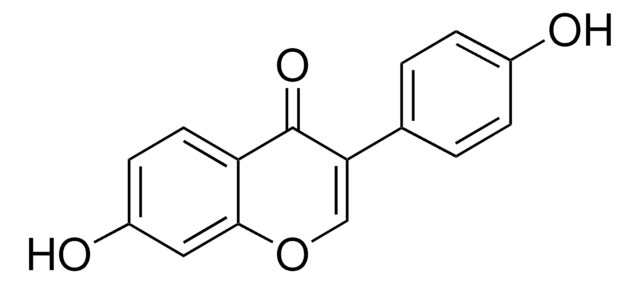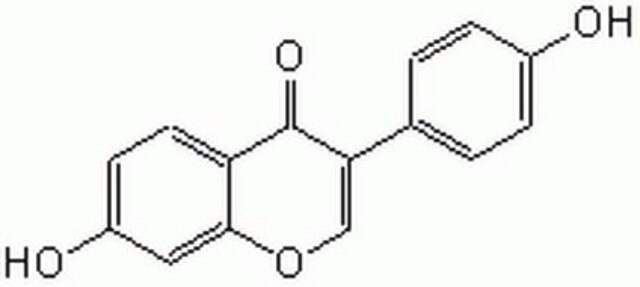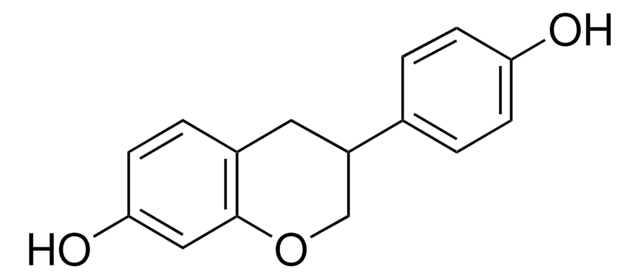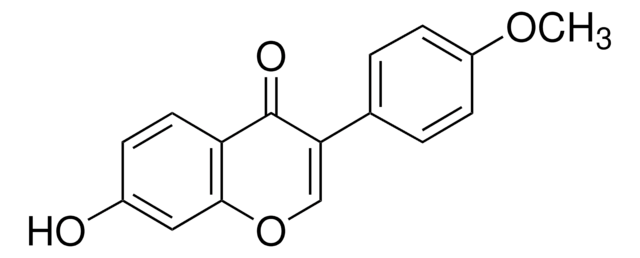D7802
Daidzein
≥98% (TLC), powder, carbonic anhydrase (CA) inhibitor
Synonyme(s) :
4′,7-Dihydroxyisoflavone, 7-Hydroxy-3-(4-hydroxyphenyl)-4H-1-benzopyran-4-one, 7-Hydroxy-3-(4-hydroxyphenyl)chromone, Isoaurostatin
About This Item
Produits recommandés
product name
Daidzein, ≥98%, synthetic
Source biologique
synthetic
Niveau de qualité
Pureté
≥98%
Forme
powder
Pf
>290 °C
Solubilité
DMSO: 10 mg/mL
Température de stockage
−20°C
Chaîne SMILES
Oc1ccc(cc1)C2=COc3cc(O)ccc3C2=O
InChI
1S/C15H10O4/c16-10-3-1-9(2-4-10)13-8-19-14-7-11(17)5-6-12(14)15(13)18/h1-8,16-17H
Clé InChI
ZQSIJRDFPHDXIC-UHFFFAOYSA-N
Informations sur le gène
human ... ESR1(2099) , ESR2(2100) , UGT1A4(54657)
mouse ... Aldh1a2(19378) , Hexa(15211) , Maoa(17161)
rat ... Aldh1a2(116676)
Vous recherchez des produits similaires ? Visite Guide de comparaison des produits
Description générale
Application
- as a control to evaluate fertility in rats
- to study its effects on ovarian cancer
- to simulate in vitro antioxidant activity
Actions biochimiques/physiologiques
Conditionnement
Mention d'avertissement
Warning
Mentions de danger
Conseils de prudence
Classification des risques
Eye Irrit. 2 - Skin Irrit. 2
Code de la classe de stockage
11 - Combustible Solids
Classe de danger pour l'eau (WGK)
WGK 3
Point d'éclair (°F)
Not applicable
Point d'éclair (°C)
Not applicable
Équipement de protection individuelle
dust mask type N95 (US), Eyeshields, Gloves
Certificats d'analyse (COA)
Recherchez un Certificats d'analyse (COA) en saisissant le numéro de lot du produit. Les numéros de lot figurent sur l'étiquette du produit après les mots "Lot" ou "Batch".
Déjà en possession de ce produit ?
Retrouvez la documentation relative aux produits que vous avez récemment achetés dans la Bibliothèque de documents.
Les clients ont également consulté
Articles
Antioxidants protect biological systems from oxidative damage produced by oxygen-containing free radicals and from redoxactive transition metal ions such as iron, copper, and cadmium.
Notre équipe de scientifiques dispose d'une expérience dans tous les secteurs de la recherche, notamment en sciences de la vie, science des matériaux, synthèse chimique, chromatographie, analyse et dans de nombreux autres domaines..
Contacter notre Service technique










